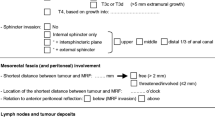Abstract
Background
Esophageal cancer has a poor prognosis, and many patients undergoing surgery have a low chance of cure. Imaging studies suggest that tumor volume is prognostic. The study aimed to evaluate pathological tumor volume (PTV) as a prognostic variable in esophageal cancer.
Methods
This single-center cohort study included 283 patients who underwent esophageal cancer resections between 2000 and 2012. PTVs were obtained from pathological measurements using a validated volume formula. The prognostic value of PTV was analyzed using multivariable regression models, adjusting for age, tumor grade, tumor (T) stage, nodal stage, lymphovascular invasion, resection margin, resection type, and chemotherapy response, which provided hazard ratios (HRs) with 95 % confidence intervals (CIs). Primary outcomes were time to death and time to recurrence. Secondary outcomes were margin involvement and lymph node positivity. Correlation analysis was performed between imaging and PTVs.
Results
On unadjusted analysis, increasing PTV was associated with worse overall mortality (HR 2.30, 95 % CI 1.41–3.73) and disease recurrence (HR 1.87, 95 % CI 1.14–3.07). Adjusted analysis demonstrated worse overall mortality with increasing PTV but reached significance in only one subgroup (HR 1.70, 95 % CI 1.09–2.38). PTV was an independent predictor of margin involvement (OR 2.28, 95 % CI 1.02–5.13) and lymph node–positive status (OR 2.77, 95 % CI 1.23–6.28). Correlation analyses demonstrated significant positive correlation between computed tomography (CT) software and formula tumor volumes (r = 0.927, p < 0.0001), CT and positron emission tomography tumor volumes (r = 0.547, p < 0.0001), and CT and PTVs (r = 0.310, p < 0.001).
Conclusions
Tumor volume may predict survival, margin status, and lymph node positivity after surgery for esophageal cancer.


Similar content being viewed by others
References
Enzinger PC, Mayer RJ. Esophageal cancer. N Engl J Med. 2003;349:2241–52.
Wu PC, Posner MC. The role of surgery in the management of esophageal cancer. Lancet Oncol. 2003;4:481–8.
Davies AR, Gossage JA, Zylstra J, et al. Tumor stage after neoadjuvant chemotherapy determines survival after surgery for adenocarcinoma of the esophagus and esophagogastric junction. J Clin Oncol. 2014;32:2983–90.
Davies AR, Pillai A, Sinha P, et al. Factors associated with early recurrence and death after esophagectomy for cancer. J Surg Oncol. 2014;109:459–64.
Lagarde SM, ten Kate FJ, Reitsma JB, Busch OR, van Lanschot JJ. Prognostic factors in adenocarcinoma of the esophagus or gastroesophageal junction. J Clin Oncol. 2006;24:4347–55.
Sloof G. Response monitoring of neoadjuvant therapy using CT, EUS and FDG-PET. Best Pract Res Clin Gastroenterol. 2006;20:941–57.
Blom RLGM, Steenbakkers IR, Lammering G, et al. PET/CT-based metabolic tumor volume for response prediction of neoadjuvant chemoradiotherapy in esophageal cancer. Eur J Nucl Med Mol Imaging. 2013;40:1500–6.
Hyun SH, Choi JY, Shim YM, et al. Prognostic value of metabolic tumor volume measured by 18F-fluorodeoxyglucose positron emission tomography in patients with esophageal carcinoma. Ann Surg Oncol. 2010;17:115–22.
Crehange G, Bosset M, Lorchel F, et al. Tumor volume as outcome determinant in patients treated with chemoradiation for locally advanced esophageal cancer. Am J Clin Oncol. 2006;29:583–7.
Hatt M, Visvikis D, Albarghach NM, Tixier F, Pradier O, Cheze-le RC. Prognostic value of (18)F-FDG PET image-based parameters in esophageal cancer and impact of tumor delineation methodology. Eur J Nucl Med Mol Imaging. 2011;38:1191–202.
Chan DSY, Fielding P, Roberts SA, Reid TD, Ellis-Owen R, Lewis WG. Prognostic significance of 18-FDG PET/CT and EUS defined tumor characteristics in patients with esophageal cancer. Clin Radiol. 2013. 68:352–7.
Wittekind C, Yamasaki S. Digestive system tumours—oesophagus including oesophagogastric junction. In: Sobin LH, Gospodarowicz MK, Wittekind CW, editors TNM classification of malignant tumours. 7th ed. New York: Wiley-Blackwell; 2009:66.
Schwartz M. A biomathematical approach to clinical tumor growth. Cancer. 1961;14:1272–94.
Hasegawa M, Sone S, Takashima S, et al. Growth rate of small lung cancers detected on mass CT screening. Br J Radiol. 2000;73(876):1252–9.
Roset A, Spadola L, Ratib O. OsiriX: an open-source software for navigating in multidimensional DICOM images. J Digit Imaging. 2004;17:205–16.
Mapstone NP. Dataset for the histopathological reporting of esophageal carcinoma. 2nd Edition. Royal College of Pathologists G006. 2007. https://www.rcpath.org/Resources/RCPath/Migrated%20Resources/Documents/G/G006OesophagealdatasetFINALFeb07.pdf. Accessed 22 Jan 2015.
Davies AR, Sandhu H, Pillai A, et al. Surgical resection strategy and the influence of radicality on outcomes in oesophageal cancer. Br J Surg. 2014;101:511–7.
Omloo JM, Lagarde SM, Hulscher JB, et al. Extended thoracic resection compared with limited transhiatal resection for adenocarcinoma of the mid/distal oesophagus: five year survival of a randomized clinical trial. Ann Surg. 2007;246:992–1000.
Siu KF, Cheung HC, Wong J. Shrinkage of the esophagus after resection for carcinoma. Ann Surg. 1986;203:173–6.
Boggs DH, Hanna A, Burrows W, Horiba N, Suntharalingham N. Primary gross tumor volume is an important prognostic factor in locally advanced esophageal cancer patients treated with trimodality therapy. J Gastrointest Cancer. 2015;46:131–7.
Jeganathan R, McGuigan J, Campbell F, Lynch T. Does pre-operative estimation of esophageal tumor metabolic length using 18F-fluorodeoxyglucose PET/CT images compare with surgical pathology length? Eur J Nucl Med Mol Imaging. 2011;38:656–62.
Acknowledgment
This research was undertaken as an ESSQ MSc thesis (L.G.C.T.).
Disclosure
The authors declare no conflict of interest.
Author information
Authors and Affiliations
Corresponding author
Additional information
For the Guy’s St. Thomas’ Oesophago-Gastric Research Group.
Rights and permissions
About this article
Cite this article
Tullie, L.G.C., Sohn, HM., Zylstra, J. et al. A Role for Tumor Volume Assessment in Resectable Esophageal Cancer. Ann Surg Oncol 23, 3063–3070 (2016). https://doi.org/10.1245/s10434-016-5228-x
Received:
Published:
Issue Date:
DOI: https://doi.org/10.1245/s10434-016-5228-x




